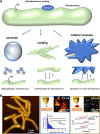Seeing and Touching the Mycomembrane at the Nanoscale
- PMID: 33468595
- PMCID: PMC8088606
- DOI: 10.1128/JB.00547-20
Seeing and Touching the Mycomembrane at the Nanoscale
Abstract
Mycobacteria have unique cell envelopes, surface properties, and growth dynamics, which all play a part in the ability of these important pathogens to infect, evade host immunity, disseminate, and resist antibiotic challenges. Recent atomic force microscopy (AFM) studies have brought new insights into the nanometer-scale ultrastructural, adhesive, and mechanical properties of mycobacteria. The molecular forces with which mycobacterial adhesins bind to host factors, like heparin and fibronectin, and the hydrophobic properties of the mycomembrane have been unraveled by AFM force spectroscopy studies. Real-time correlative AFM and fluorescence imaging have delineated a complex interplay between surface ultrastructure, tensile stresses within the cell envelope, and cellular processes leading to division. The unique capabilities of AFM, which include subdiffraction-limit topographic imaging and piconewton force sensitivity, have great potential to resolve important questions that remain unanswered on the molecular interactions, surface properties, and growth dynamics of this important class of pathogens.
Keywords: adhesins; atomic force microscopy; binding force; chemical properties; drugs; growth dynamics; mycobacterial envelope; ultrastructure.
Copyright © 2021 American Society for Microbiology.
Figures



References
Publication types
MeSH terms
Substances
LinkOut - more resources
Full Text Sources
Other Literature Sources
Miscellaneous

